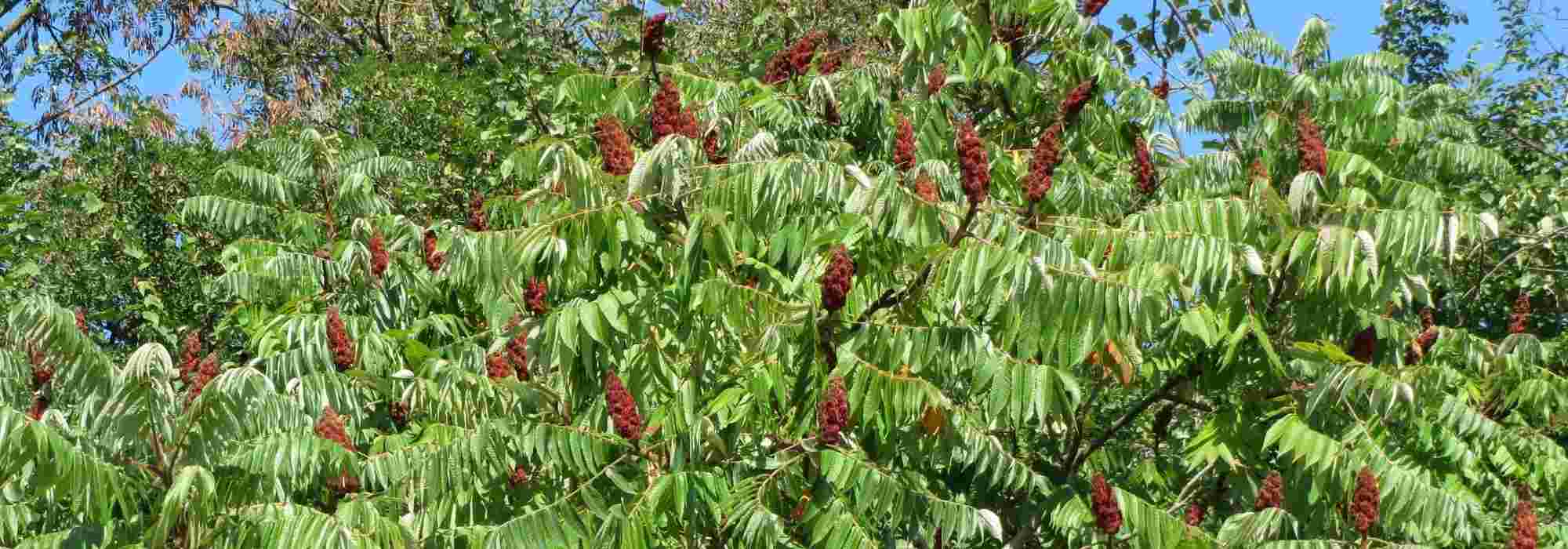
Sumac, vinegar tree: planting, growing and care
Contents
Sumacs in a nutshell
- Best known of them is staghorn sumac, also known as vinegar tree
- Sumacs are notable for their foliage colour in autumn
- Plant in full sun in any well-drained soil
- Extremely hardy, sumacs are also tolerant of drought and air pollution
- It is a very suckering bush, so fairly invasive but easy to contain.
A word from our expert
Rare are bushes as flamboyant as Virginia sumac in autumn. It is hard to miss with its wonderful, deeply divided leaves turning warm colours, from bright orange to crimson red, as days shorten. Its striking deep-purple, torch-shaped fruits remain on the tree throughout winter, an added attraction.
Virginia sumac grows in full sun but tolerates partial shade. It prefers ordinary but well-drained soil. In addition, it has exceptional hardiness, withstands drought once established and does not fear air pollution.
Alas, its reputation as an invasive bush does it no favours. Its tendency to produce suckers can quickly become problematic if not kept in check but… this can become a real blessing to prevent erosion on a bank, for example, or to green quickly a somewhat forgotten spot where nothing seemed to want to grow.
A true gem of sculptural botany, Virginia sumac seems carved in transparency yet it is its natural habit that casts only a light, beneficial shade within a bed of perennials and low bushes, or at the heart of a naturalistic meadow garden planted with flowering North American perennials. An opportunity to create in your garden a prodigious, multicoloured impressionist picture in autumn whose signature could well be by Piet Outdolf.
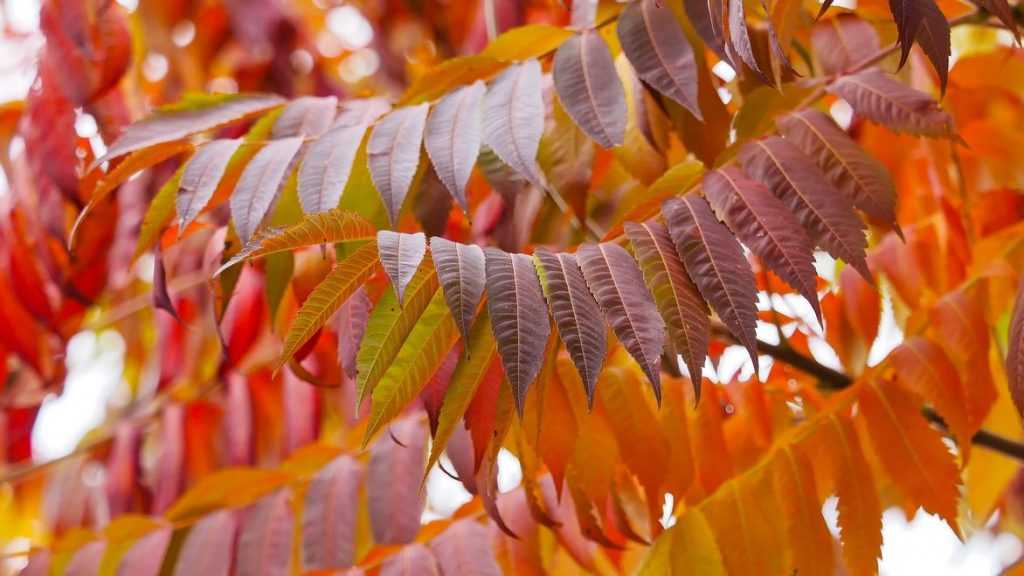
Spectacular foliage in autumn
Description and botany
Botanical data
- Latin name Rhus sp.
- Family Anacardiaceae
- Common name staghorn sumac, vinegar tree, amaranth sumac
- Flowering June-July
- Height 4 m
- Sun exposure sun
- Soil type ordinary but well-drained
- Hardiness -28°C
Genus Rhus belongs to family Anacardiaceae. This name may mean nothing to you but it is the family that includes Cotinus, pistachio trees, mango trees and the cashew tree that provides cashew nuts. Genus Rhus contains, according to recent classifications, about 125 different species distributed across both hemispheres of the globe: Rhus typhina, Rhus glabra, Rhus aromatica, Rhus coriaria, Rhus microphylla, Rhus potaninii, Rhus X pulvinata (a hybrid between R. typhina and R. glabra), … The three most commonly planted Rhus, also called sumac, are Rhus typhina or staghorn sumac, Rhus glabra or smooth sumac and Rhus aromatica or aromatic sumac.
Formerly species of genus Toxicodendron were classed in genus Rhus: Rhus radicans (climbing sumac) became Toxicodendron radicans, Rhus toxicodendron became Toxicodendron pubescens, Rhus verniciflua (Japanese lacquer tree) became Toxicodendron vernicifluum and Rhus succedanea became Toxicodendron succedanea. Do not be surprised to encounter these names in older works. All species of genus Toxicodendron contain urushiol, a non-volatile oil that can cause severe dermatitis in most people.
Genera Rhus and Toxicodendron are quite diverse. They include trees over 20 m tall such as the lacquer tree, grown ornamentally but also for its resin used to make lacquer; deciduous bushes like most sumacs; and also lianas such as the climbing sumac, Toxicodendron radicans, native to western America. Some evergreen “sumacs” from Africa, best reserved for mild climates, were formerly classed in genus Rhus and are now placed in genus Searsea: Searsea lancea or willow-leaved sumac and Searsea pendulina or weeping sumac.
Rhus typhina or staghorn sumac and Rhus glabra
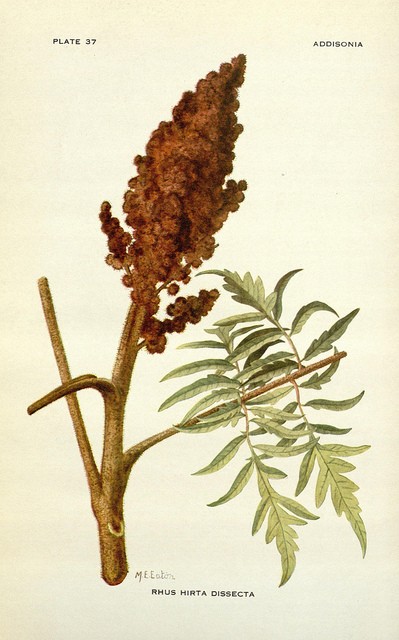
Rhus typhina – botanical illustration
The most famous among them is undoubtedly Rhus typhina, staghorn sumac, vinegar tree or amaranth sumac (also found under its former name Rhus hirta), introduced into Europe as early as 1624. It is a deciduous bush native to eastern North America. It grows at forest edge, which is why it prefers full sun that will give it its magnificent autumn colours. It likes ordinary, fairly fertile and well-drained soils. In heavy, clay soil consider a draining layer at planting (sand or compost). It is entirely indifferent to soil pH.
It is an upright bush about 4 m high (10 m in its native habitat) and as wide. It quickly thins out at the base to adopt a tree habit and a naturally ‘transparent’ silhouette. It produces many suckers, especially when roots are damaged, which makes it a rather invasive bush but very useful to prevent erosion on slopes or to quickly vegetate a neglected spot. Bark is brown‑grey. Young shoots are tomentose (downy) and wood fairly brittle. If a branch is cut, a white latex may flow and the central wood is yellow.
Its foliage is the most spectacular feature. Staghorn sumac has deciduous leaves, odd-pinnate (odd number of leaflets) and alternate, up to 50 cm long, light green during the season then orange-scarlet in autumn, with oblong, deeply divided and toothed leaflets (even more so on cultivar ‘Dissecta’).
It is a dioecious species, which means there are male and female plants. Greenish flowers in compact panicles give rise on female plants to fuzzy fruits, drupes, shaped like a torch and purple in colour that remain on the plant all winter. The name “vinegar tree” comes from the fact that a tart lemonade can be made from its fruits. Seeds are very hard and need to pass through an animal’s stomach to germinate.
With a lifespan of between 50 and 100 years, it has moderate growth but reaches sexual maturity in barely 6 years.
It is extremely hardy, down to -28°C. However, its subtropical origins have not taught it to beware of frost. Indeed, the tree does not lignify its annual young shoots in time, which means their tips are burnt every winter without consequence for the bush. It is particularly drought- and air pollution‑tolerant. It is also melliferous and its flowers attract numerous butterflies.
Rhus glabra, also called vinegar tree, is very similar to its cousin. It differs only by its size, slightly smaller at maturity (3 m tall), and by its glabrous young shoots, hence its name. Hybridisation is possible between the two and has given rise to Rhus × pulvinata.
Rhus coriaria or tanner’s sumac
Also called traveller’s sumac, Rhus coriaria is commonly found in Mediterranean garrigue. It is a 4 m high bush with green foliage that turns grey beneath. In autumn leaves take colours ranging from pink to yellow. Not its only attraction: young shoots are pink and the rust-brown fruits remain on the plant once bare, as with other sumacs.
Rhus aromatica or aromatic sumac
Although it resembles (from a distance!) the poison sumac (Toxicodendron radicans), aromatic sumac is not toxic at all. This charming creeping shrub is perfect for vegetating natural areas of the garden or tricky corners. It grows everywhere without trouble and provides red berries for birds in autumn, when its foliage turns magnificent red‑orange colours. Its name comes from the fact that crushing the leaves releases subtle notes of citrus.
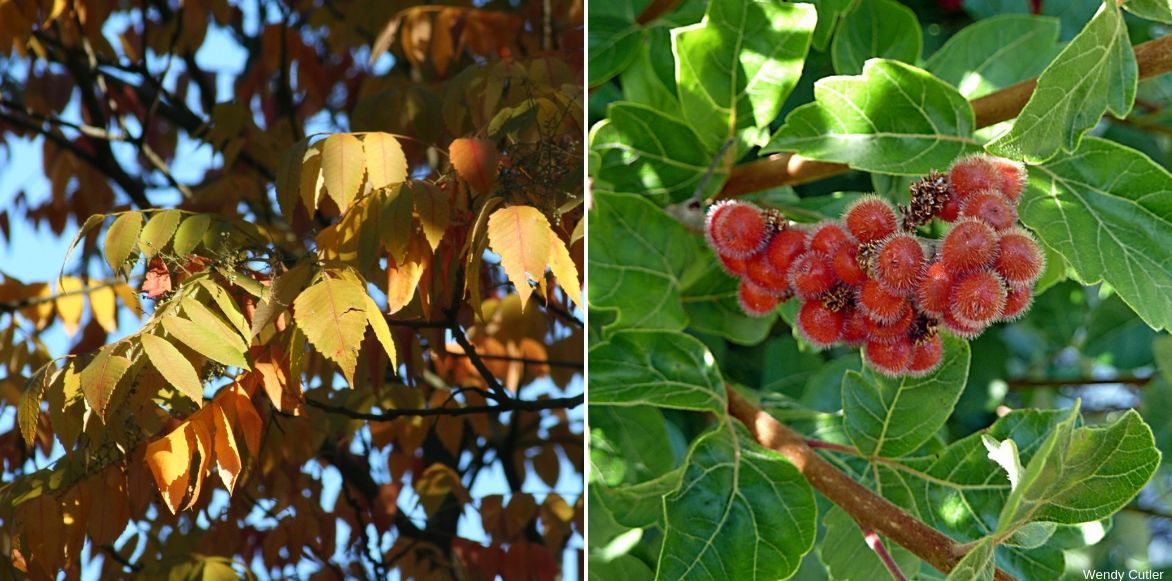
Aromatic sumac: autumn foliage and red berries enjoyed by birds
Toxicodendron vernicifluum or Japanese lacquer tree
This one, however, is toxic! But could one blame such a beautiful tree? Reaching nearly 20 m high, the “true” Japanese lacquer tree should not be confused with Ailanthus altissima, despite a real likeness. This tree prefers moist but well-drained soils and is hardy only to -10°C. It loves full sun but should be sheltered from strong winds because of its brittle wood. Otherwise, it is a charming tree that will reward with a lovely orange colour in autumn.
Nota bene: many people confuse sumacs and notably Toxicodendron vernicifluum aka the Japanese lacquer tree with Ailanthus altissima, the tree-of-heaven, also sometimes called… Chinese lacquer tree or faux Japanese lacquer, which only fuels the confusion further… Ailanthus, however, belongs to family Simaroubaceae and even if its foliage may resemble that of a young sumac, its fruiting is completely different.
Our favourite varieties
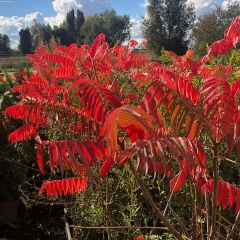
Rhus typhina - Stag's Horn Sumach
- Flowering time July to September
- Height at maturity 5 m
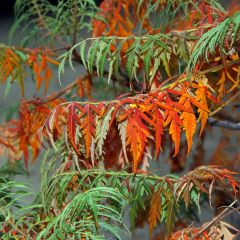
Rhus glabra Laciniata - Fern-leaved Sumach
- Flowering time July to September
- Height at maturity 2,50 m
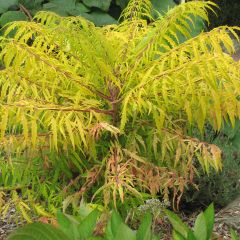
Rhus typhina Tiger Eyes - Stag's Horn Sumach
- Flowering time July to September
- Height at maturity 2,50 m
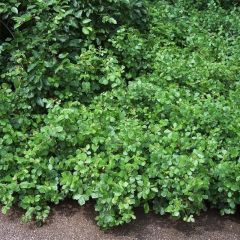
Rhus aromatica Gro-Low - Fragrant Sumach
- Flowering time April, May
- Height at maturity 50 cm
Discover other Rhus - Sumac
View all →Available in 1 sizes
Available in 3 sizes
Available in 1 sizes
Available in 1 sizes
Available in 1 sizes
Planting sumac
Where and when to plant?
Sumac prefers ordinary, fairly rich, well-drained soil. If your soil is heavy and clayey, consider placing some compost or sand at bottom of planting hole. Good moisture is appreciated without excess but once well established, it tolerates drought very well. It is indifferent to soil pH. Plant at very start of autumn in September–October or, failing that, in March–April.
Although also comfortable in partial shade, it will reward you with the most beautiful foliage colours in autumn when planted in full sun. Avoid planting in exposed, windy sites. Indeed, although it hardly minds and is very tolerant of sea spray, it may lose its leaves prematurely in autumn. Which would be a shame…
How to plant?
- Soak pot in water for one hour to moisten rootball
- Dig hole twice volume of rootball. If soil is compact, clayey or poorly drained, consider placing some sand or compost at bottom of hole.
- Remove rootball from pot and gently start to break it up. If you damage roots at this stage, your sumac will produce suckers as soon as it’s established.
- To prevent it from producing suckers, place a rootstock barrier around your bush. Or plant only a low-suckering variety (see our favourite varieties).
- Place rootball in bottom of hole and backfill with excavated soil.
- Give a generous watering to avoid air pockets between soil and roots.
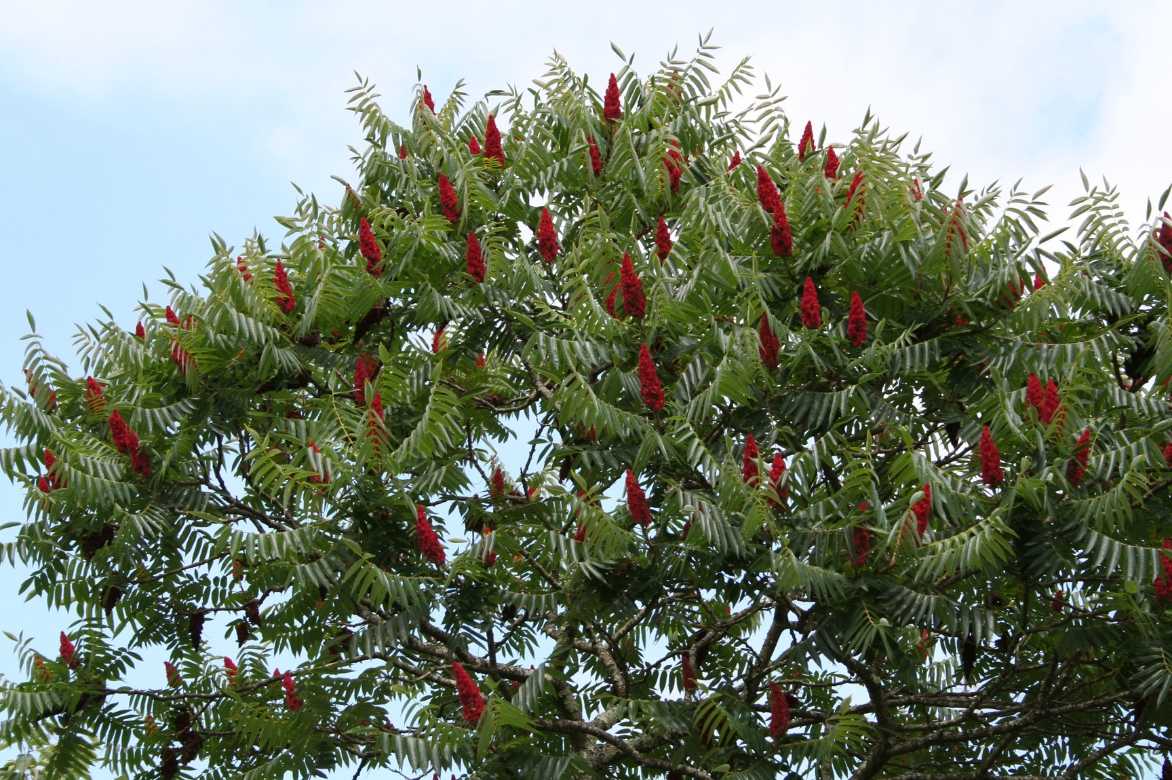
Rhus typhina and its characteristic purplish, torch-shaped fruits
Read also
How to prevent coral disease?Propagation of sumac
Sowing, propagation by cuttings and layering
Sowing is possible. By collecting seeds from fertilised fruits, which means you must be certain that a male sumac is roaming around your female sumac (as she bears the fruits…). Soak them in water for three days to soften the shell then sow under a cold frame at a temperature of 20–25°C.
Propagation by cuttings of root sections and air layering is also theoretically possible, but there is a much simpler method (see below).
Separating suckers
This is clearly the best solution. Except for the Virginia sumac Tiger Eyes, a recent variety, sumacs are suckering. You only need to find a healthy sucker well supplied with adventive roots and cut sharply with a spade blade the end of the root that holds it to “free” the young sumac from the parent plant. You then just need to plant it elsewhere in your garden or in a friend’s garden.
Care and pruning of Sumac
Maintenance and pruning
Sumac requires little or no maintenance. First year after planting, you can consider giving it a little water if conditions are particularly dry. Afterwards, let your bush fend for itself.
For pruning, Vinaigrier is a bush that naturally presents a thinned branches habit, which is part of its elegance. You can however remove dead wood and any misplaced branches in February–March. If you want a more ramified bush, you can cut it back to three buds above soil; it will regrow denser afterwards.
Be careful with its roots! The more you damage them, the more it will sucker. If it suckers a lot, do not hesitate to pull out any sucker that emerges from the ground, especially within a bed.
Diseases and parasitic pests
Not very susceptible to disease, sumacs can nevertheless show some symptoms of coral disease: orange then red pustules appear on certain branches when the bush is weakened (overly severe pruning, drought in first year, …). Cut the affected branches and burn them, then apply a fungicidal product such as Bordeaux mixture. No need to worry, however, coral disease is fairly rare on sumacs.
→ Discover our advice sheet : “How to prevent coral disease”
Associations
Focal point of a naturalistic meadow
Imagine a lovely little corner of meadow planted with grasses and late-flowering perennials native to North America. And then suddenly your eye is caught by a vivid red element emerging from those tall, airy perennials. It’s Rhus typhina ‘Tiger Eyes’, a superb non-invasive Virginia sumac with deeply cut chartreuse-green foliage in spring turning bright red in autumn. The meadow will be composed of Verbena bonariensis, pink Echinacea or pale yellow Echinacea, a few clumps of bee balm (Monarda), one or two Cimicifuga racemosa and handsome tall, airy grasses: Deschampsia cespitosa, Molinia or Panicum virgatum.

An example of a naturalistic planting: Rhus typhina ‘Tiger Eyes’, Verbena bonariensis, Deschampsia cespitosa, Echinacea purpurea, Cimicifuga racemosa, Monarda ‘Scorpion’
Competition for the most beautiful autumn colour
You love autumn. I understand — this season has enormous charm! Why not go the whole way by creating a copse that will amaze your friends as soon as days shorten. Plant magnificent Rhus glabra ‘laciniata’: its very deeply cut foliage and many autumn hues will surely delight. Give it a setting of Nyssa sylvatica, an American that also favours moist soil and turns bright orange in autumn, and Amelanchier from Canada, which will adopt beautiful colours while providing edible fruit. If you have a little space left, try another American, Liquidambar, which is notable for offering multicoloured autumn foliage: yellow, orange, red, purple and even black. As groundcover, a Cornus canadensis tapetum will look splendid, all punctate with a few clumps of Aster divaricatus. And that’s all there is to it!

An example of an autumnal planting: Rhus glabra ‘Laciniata’, Amelanchier lamarckii (or canadensis), Aster divaricatus, Nyssa sylvatica, Cornus canadensis, Liquidambar styraciflua
For more ideas of dazzling autumn foliage, discover Eva’s article : “Most beautiful trees and bushes with autumn colouring”
Useless anecdotes
- The name Sumac comes from Syriac and simply means “red”
- Rhus coriaria produces edible berries which, when ground to a powder, yield a spice prized around the Mediterranean. This bush also produces a yellow-orange dye and is used for leather tanning.
- A resin is extracted from Toxicodendron vernicifluum, the “true” Japanese lacquer, which is turned into a varnish used to lacquer furniture and other wood objects of Asian craft.
- Fruits of Rhus typhina and Rhus glabra are used to make a tart drink called “Indian lemonade”.
- Sumac trees can be host to a gall produced by an aphid named Melaphis rhois.
- Leaves of Rhus aromatica can be dried and used in an infusion.
Useful resources
Discover all our sumacs at our nursery.
A very fine collection of Rhus and Toxicodendron can be found at Bokrijk Arboretum in Belgium.
Frequently asked questions
-
How can I prevent my sumac from becoming invasive?
Several options are available. When planting, you can install a rootstock barrier that will effectively restrain its vigour. Alternatively, remove suckers as soon as they appear. Best solution, in my opinion, is to plant only sumac varieties known to be non-invasive, such as Rhus thypina 'Tiger Eyes', which is also one of the most beautiful ornamental varieties.
-
Is it true that sumac is toxic?
It is mainly 'sumacs' of genus Toxicodendron that are most dangerous and cause severe dermatitis. With Rhus typhina and Rhus glabra, beware of sap and avoid contact with skin. If that happens despite all precautions, rinse affected area thoroughly with water and everything will be fine.
- Subscribe!
- Contents
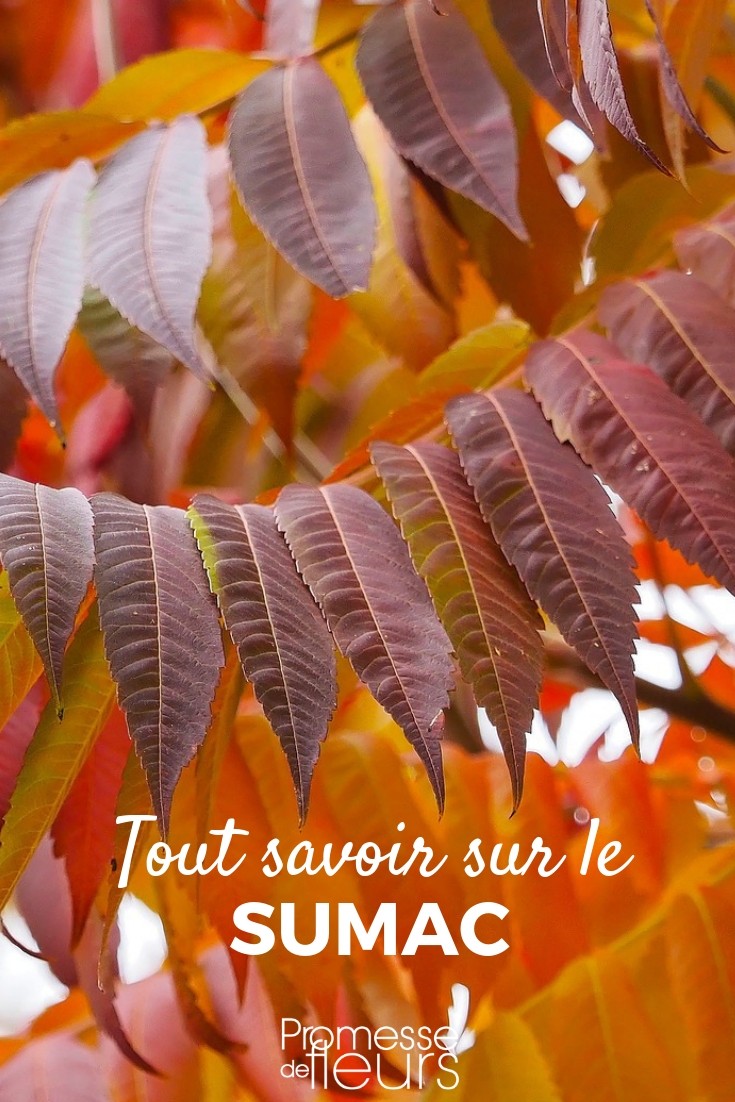


































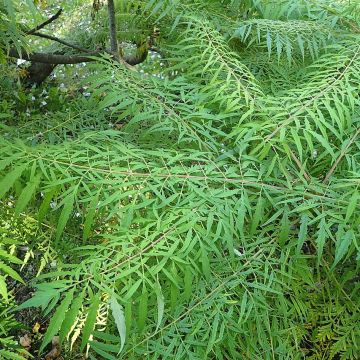

Comments